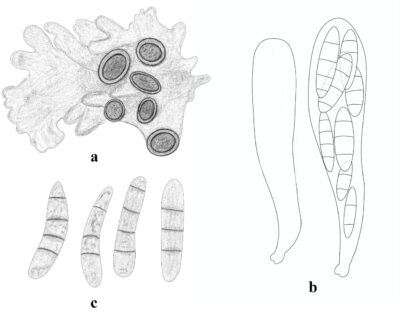Fungalpedia – Note 405, Callome
Callome Otálora & Wedin
Citation when using this data: Tibpromma et al. (in prep.) – Fungalpedia, Liu et al., lichenicolous fungi, Mycosphere.
Index Fungorum, Facesoffungi, MycoBank, GenBank, Fig. X
Classification: Collemataceae, Peltigerales, Lecanoromycetidae, Lecanoromycetes, Pezizomycotina, Ascomycota, Fungi.
Based on the morphology and analyses of multigene phylogeny (LSU, SSU, MCM7, and TUB2), Otálora et al. (2014) introduced Callome to accommodate the type species Callome multipartita as a revision of Collema multipartitum. Callome was isolated from lichen, which restricted to Europe, Northern Africa and North America (Otálora et al. 2014). Currently, only one species was accepted in this genus only with the sexual morph. Callome is characterized by foliose, dark olive green to black thallus with smooth, irregular, deeply, and repeatedly branched lobes, 8-spored asci, and linear oblong, straight, or curved spores with transverse septate (Otálora et al. 2014). Callome is phylogenetically sister to Rostania but they can be distinguished by different thallus habitus, ecology, ascospore shape and septation (Otálora et al. 2014). Morphologically, Callome is similar to Lathagrium by repeatedly branched thallus; however, the latter has flat to concave lobes, and submuriform, fusiform to cylindrical spores (Otálora et al. 2014, Cannon et al. 2020).
Type species: Callome multipartita (Sm.) Otálora, P.M. Jørg. & Wedin
Other accepted species: This genus is monotypic.
Figure 1 – Morphological features Callome multipartita. a Apothecia on lichen. b Asci. c Ascospores. Redrawn from FRDBI (2023).
References
Entry by
Liu XF, Center for Yunnan Plateau Biological Resources Protection and Utilization, College of Biological Resource and Food Engineering, Qujing Normal University, Qujing, Yunnan 655011, China; Center of Excellence in Fungal Research, Mae Fah Luang University, Chiang Rai 57100, Thailand; School of Science, Mae Fah Luang University, Chiang Rai 57100, Thailand.
(Edited by Saowaluck Tibpromma, Samaneh Chaharmiri-Dokhaharani, & Achala R. Rathnayaka)
Published online 26 November 2024
